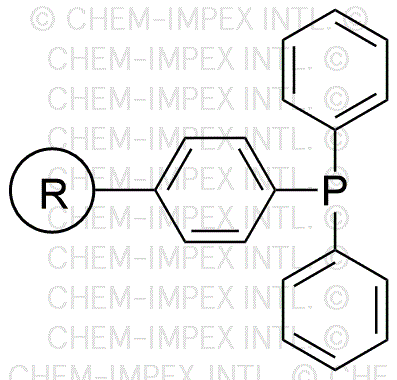Triphenylphosphine resin is widely utilized in research focused on:
- Organic Synthesis: This resin serves as a valuable reagent in various organic reactions, particularly in the synthesis of phosphonium salts and other organophosphorus compounds, enhancing reaction efficiency.
- Solid-Phase Extraction: It is employed in solid-phase extraction processes to purify and isolate compounds from complex mixtures, making it essential in analytical chemistry and environmental testing.
- Catalysis: The resin acts as a catalyst support in numerous chemical reactions, providing a stable platform that improves reaction rates and selectivity, which is beneficial in pharmaceutical manufacturing.
- Bioconjugation: In biochemistry, it is used for attaching biomolecules to surfaces, facilitating the development of biosensors and drug delivery systems, thus enhancing therapeutic efficacy.
- Polymer Chemistry: This resin plays a role in the development of polymeric materials, where it contributes to the modification of polymer properties, leading to advanced materials with tailored functionalities.
General Information
Properties
Safety and Regulations
Applications
Triphenylphosphine resin is widely utilized in research focused on:
- Organic Synthesis: This resin serves as a valuable reagent in various organic reactions, particularly in the synthesis of phosphonium salts and other organophosphorus compounds, enhancing reaction efficiency.
- Solid-Phase Extraction: It is employed in solid-phase extraction processes to purify and isolate compounds from complex mixtures, making it essential in analytical chemistry and environmental testing.
- Catalysis: The resin acts as a catalyst support in numerous chemical reactions, providing a stable platform that improves reaction rates and selectivity, which is beneficial in pharmaceutical manufacturing.
- Bioconjugation: In biochemistry, it is used for attaching biomolecules to surfaces, facilitating the development of biosensors and drug delivery systems, thus enhancing therapeutic efficacy.
- Polymer Chemistry: This resin plays a role in the development of polymeric materials, where it contributes to the modification of polymer properties, leading to advanced materials with tailored functionalities.
Documents
Safety Data Sheets (SDS)
The SDS provides comprehensive safety information on handling, storage, and disposal of the product.
Product Specification (PS)
The PS provides a comprehensive breakdown of the product’s properties, including chemical composition, physical state, purity, and storage requirements. It also details acceptable quality ranges and the product's intended applications.
Certificates of Analysis (COA)
Search for Certificates of Analysis (COA) by entering the products Lot Number. Lot and Batch Numbers can be found on a product’s label following the words ‘Lot’ or ‘Batch’.
Numéro de catalogue
Numéro de lot/série
Certificates Of Origin (COO)
This COO confirms the country where the product was manufactured, and also details the materials and components used in it and whether it is derived from natural, synthetic, or other specific sources. This certificate may be required for customs, trade, and regulatory compliance.
Numéro de catalogue
Numéro de lot/série
Safety Data Sheets (SDS)
The SDS provides comprehensive safety information on handling, storage, and disposal of the product.
DownloadProduct Specification (PS)
The PS provides a comprehensive breakdown of the product’s properties, including chemical composition, physical state, purity, and storage requirements. It also details acceptable quality ranges and the product's intended applications.
DownloadCertificates of Analysis (COA)
Search for Certificates of Analysis (COA) by entering the products Lot Number. Lot and Batch Numbers can be found on a product’s label following the words ‘Lot’ or ‘Batch’.
Numéro de catalogue
Numéro de lot/série
Certificates Of Origin (COO)
This COO confirms the country where the product was manufactured, and also details the materials and components used in it and whether it is derived from natural, synthetic, or other specific sources. This certificate may be required for customs, trade, and regulatory compliance.


